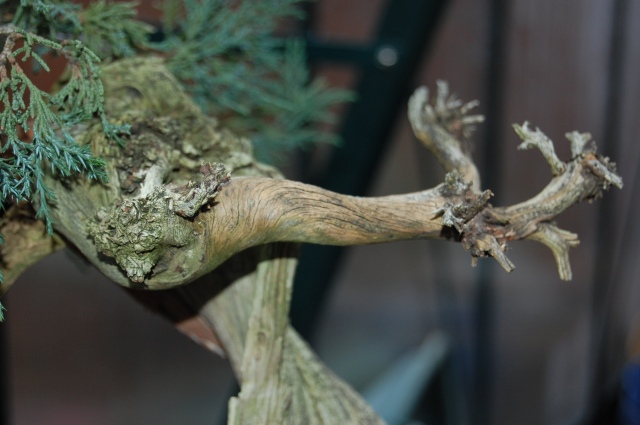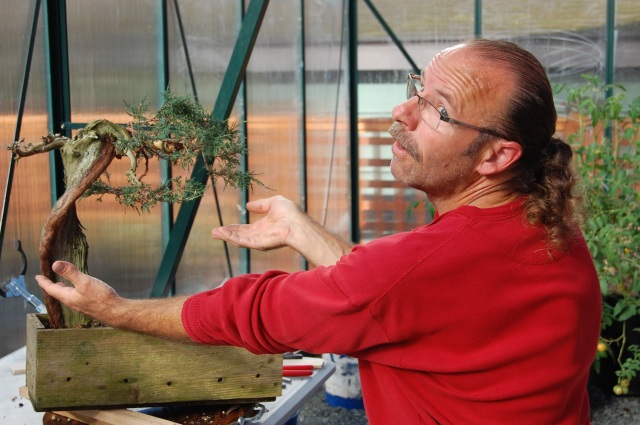Another post you say? And another Alaska Yellow-Cedar? AKA Chamaecyparis nootkatensis? None other than 😉 Why would I quit after just one? And It wasn’t mine, after all. So while I in Seattle, I took a little trip to Bremerton to visit Dan Robinson, owner and curator of Elandan Gardens. I wanted to see if he had any more of these available and was pleased to find several of them to choose from, both in size and price. I walked right past the tree I eventually wound up with and only saw it when Dan caught up with us and picked it right off the ground and said, ‘I thought this is the one you wanted’. Indeed it was. I called ahead of my visit to make sure Dan would be there and indicated I was in the market for a small AK cedar. Let’s take a look at the tree as it arrived from its Seattle origin:
It was just a year ago I brought one of these into my garden, looking a lot like this–a really sexy, muscular trunk topped by long, lanky branches with rather coarse looking foliage. I have learned from styling the first tree that with careful pruning and wiring and then cutting new shoots, that the foliage ‘problem’ can be remedied. Another shot with the tree tilted slightly to the right and my camera lens cap in there for scale:
The lens cap is 2″ in diameter, which is roughly the same as the trunk. You’ll soon see other views of the tree but this choice for the front is the one that ‘talks’ to me. When I finished my ‘before’ photos, I hoisted her up on the bench and started cleaning the trunk of old, flaky bark. In the process, I discovered a long, thick branch near the top of the tree I hadn’t planned on using for anything:
A closer shot for you to see:
My knee-jerk reaction to such an offensive branch as this was to cut it off leaving a stub for a ‘jin’ or broken branch. And since I was going to cut it off anyway, I tested it for flexibility. If it broke or snapped, who cares? I was pleasantly surprised that it was quite limber and flexible–a good sign for the rest of the branches I planned to keep…and then, while I had it down in the lower position, a thought occurred to keep that branch as a ‘safety branch’, a kind of insurance policy in case I messed up any of the other important branches I had planned to keep! And thus it was so; I kept it and used it to anchor another branch just as thick with some six gauge copper wire. The next photo shows the tree turned around to the ‘front’ again. Can you see the offending branch any more?
It’s there, I assure you–as a ‘back branch’ being used to give the tree a greater sense of depth. You can also see the larger branches have been wired and I also pruned out the really long branches I found emerging from areas on the trunk and larger branches in clusters. If I left all the branches in these clusters, they would eventually create an unsightly bulge or thickening and ruin the taper. That’s where I had to leave it for that day, as I had to mow the lawn before our first big November storm. The next photo is from the day after, and after several hours of wiring the finer branches:
All went fairly well and I only broke one branch that actually tore more than snapped. That’s what I like about this species is its toughness and resilience. I’m hoping that by styling it in the fall as opposed to winter as I did with the first one I worked, it will get a little ‘jump’ in the sometimes long process of going from raw material to a bonsai. I will keep this one on the ground as soon as freezing weather arrives and in an area of the garden that also has protection from wind. And like the last post, I’d like to leave you with a photo of some colorful mushrooms that sprouted from the base of one of my collected Hawthorns…enjoy!






























